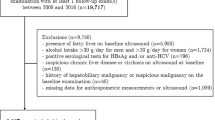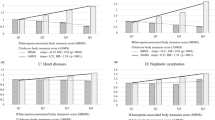Abstract
Few studies have examined the relationship between myosteatosis and hypertension, and no studies have enrolled an Asian population. Existing studies also found discordant results, possibly due to the use of conventional myosteatosis indices that are not sufficiently reliable and representative. Therefore, we investigated the association between myosteatosis and hypertension in Asian individuals using novel, objective computed tomography (CT) markers. The total abdominal muscle area (TAMA) was determined from abdominal CT scans taken at the L3 level. Based on the mean CT attenuation, the TAMA was divided into intramuscular adipose tissue and skeletal muscle area (SMA), which was further segmented into normal attenuation muscle area (NAMA) and low attenuation muscle area (LAMA). Among SMA/body mass index (BMI), NAMA/BMI, LAMA/BMI, and the NAMA/TAMA index, NAMA/BMI was chosen through receiver operating characteristic curves as the best predictive marker for hypertension. The hypertension risk for each quartile of NAMA/BMI was calculated by logistic regression analysis. Among the 19,766 participants, 40.3% of men and 23.8% of women had hypertension. People with hypertension showed unhealthier myosteatosis profiles than normotensive controls. Similarly, a lower NAMA/BMI was significantly associated with a greater hypertension risk. The lowest quartile group of NAMA/BMI exhibited 2.3- and 2.6-fold higher risks of hypertension than the highest quartile in men and women, respectively. In conclusion, advanced myosteatosis assessed by abdominal CT was significantly correlated with a higher risk of hypertension. Improving myosteatosis may be a new approach for preventing cardiovascular diseases, including hypertension.

Advanced myosteatosis measured by abdominal CT taken at the L3 level was significantly correlated with a higher risk of hypertension even after adjusting for health behaviors, intake of lipid-lowering drugs, plasma lipid levels, and other ectopic fat distribution.
This is a preview of subscription content, access via your institution
Access options
Subscribe to this journal
Receive 12 print issues and online access
$259.00 per year
only $21.58 per issue
Buy this article
- Purchase on Springer Link
- Instant access to full article PDF
Prices may be subject to local taxes which are calculated during checkout



Similar content being viewed by others
References
Cruz-Jentoft AJ, Bahat G, Bauer J, Boirie Y, Bruyère O, Cederholm T, et al. Sarcopenia: Revised European consensus on definition and diagnosis. Age Ageing. 2019;48:16–31.
Miljkovic I, Zmuda JM. Epidemiology of myosteatosis. Curr Opin Clin Nutr Metab Care. 2010;13:260–4.
Koo BK. Assessment of muscle quantity, quality and function. J Obes Metab Syndr. 2022;31:9–16.
Correa-de-Araujo R, Addison O, Miljkovic I, Goodpaster BH, Bergman BC, Clark RV, et al. Myosteatosis in the context of skeletal muscle function deficit: An interdisciplinary workshop at the national institute on aging. Front Physiol. 2020;11:963.
Miljkovic I, Vella CA, Allison M. Computed tomography-derived myosteatosis and metabolic disorders. Diabetes Metab J. 2021;45:482–91.
Maltais A, Alméras N, Lemieux I, Tremblay A, Bergeron J, Poirier P, et al. Trunk muscle quality assessed by computed tomography: Association with adiposity indices and glucose tolerance in men. Metabolism. 2018;85:205–12.
Terry JG, Shay CM, Schreiner PJ, Jacobs DR Jr, Sanchez OA, Reis JP, et al. Intermuscular adipose tissue and subclinical coronary artery calcification in midlife: The CARDIA Study (Coronary Artery Risk Development in Young Adults). Arterioscler Thromb Vasc Biol. 2017;37:2370–8.
Nachit M, Kwanten WJ, Thissen JP, Op De Beeck B, Van Gaal L, Vonghia L, et al. Muscle fat content is strongly associated with NASH: A longitudinal study in patients with morbid obesity. J Hepatol. 2021;75:292–301.
Kim HK, Kim CH. Quality matters as much as quantity of skeletal muscle: clinical implications of myosteatosis in cardiometabolic health. Endocrinol Metab (Seoul). 2021;36:1161–74.
Goodpaster BH, Kelley DE, Thaete FL, He J, Ross R. Skeletal muscle attenuation determined by computed tomography is associated with skeletal muscle lipid content. J Appl Physiol (1985). 2000;89:104–10.
Park JH, Lim NK, Park HY. Relative handgrip strength is inversely associated with hypertension in consideration of visceral adipose dysfunction: A nationwide cross-sectional study in Korea. Front Physiol. 2022;13:930922.
Najafi F, Darbandi M, Rezaeian S, Hamzeh B, Moradinazar M, Shakiba E, et al. Relative Handgrip Strength and Incidence of Hypertension: A Case-Cohort Study From Ravansar Non-Communicable Diseases Cohort. J Phys Act Health. 2022; (e-pub ahead of print 20220906 2022; https://doi.org/10.1123/jpah.2021-0774). 1–7.
Lawman HG, Troiano RP, Perna FM, Wang CY, Fryar CD, Ogden CL. Associations of relative handgrip strength and cardiovascular disease biomarkers in U.S. Adults, 2011-2012. Am J Prev Med. 2016;50:677–83.
Maslow AL, Sui X, Colabianchi N, Hussey J, Blair SN. Muscular strength and incident hypertension in normotensive and prehypertensive men. Med Sci Sports Exerc. 2010;42:288–95.
Therkelsen KE, Pedley A, Speliotes EK, Massaro JM, Murabito J, Hoffmann U, et al. Intramuscular fat and associations with metabolic risk factors in the Framingham Heart Study. Arterioscler Thromb Vasc Biol. 2013;33:863–70.
Ding J, Visser M, Kritchevsky SB, Nevitt M, Newman A, Sutton-Tyrrell K, et al. The association of regional fat depots with hypertension in older persons of white and African American ethnicity. Am J Hypertens. 2004;17:971–6.
Zhao Q, Zmuda JM, Kuipers AL, Bunker CH, Patrick AL, Youk AO, et al. Muscle attenuation is associated with newly developed hypertension in men of African ancestry. Hypertension. 2017;69:957–63.
Eastwood SV, Tillin T, Wright A, Mayet J, Godsland I, Forouhi NG, et al. Thigh fat and muscle each contribute to excess cardiometabolic risk in South Asians, independent of visceral adipose tissue. Obes (Silver Spring). 2014;22:2071–9.
Miljkovic I, Cauley JA, Petit MA, Ensrud KE, Strotmeyer E, Sheu Y, et al. Greater adipose tissue infiltration in skeletal muscle among older men of African ancestry. J Clin Endocrinol Metab. 2009;94:2735–42.
Muntner P, Shimbo D, Carey RM, Charleston JB, Gaillard T, Misra S, et al. Measurement of blood pressure in humans: A scientific statement from the American heart association. Hypertension. 2019;73:e35–e66.
Kim HK, Kim KW, Kim EH, Lee MJ, Bae SJ, Ko Y, et al. Age-related changes in muscle quality and development of diagnostic cutoff points for myosteatosis in lumbar skeletal muscles measured by CT scan. Clin Nutr. 2021;40:4022–8.
Park HJ, Shin Y, Park J, Kim H, Lee IS, Seo DW, et al. Development and validation of a deep learning system for segmentation of abdominal muscle and fat on computed tomography. Korean J Radio. 2020;21:88–100.
Anderson DE, D’Agostino JM, Bruno AG, Demissie S, Kiel DP, Bouxsein ML. Variations of CT-based trunk muscle attenuation by age, sex, and specific muscle. J Gerontol A Biol Sci Med Sci. 2013;68:317–23.
van Vugt JLA, Coebergh van den Braak RRJ, Schippers HJW, Veen KM, Levolger S, de Bruin RWF, et al. Contrast-enhancement influences skeletal muscle density, but not skeletal muscle mass, measurements on computed tomography. Clin Nutr. 2018;37:1707–14.
Derstine BA, Holcombe SA, Goulson RL, Ross BE, Wang NC, Sullivan JA, et al. Quantifying sarcopenia reference values using lumbar and thoracic muscle areas in a healthy population. J Nutr Health Aging. 2017;21:180–5.
Sachs S, Zarini S, Kahn DE, Harrison KA, Perreault L, Phang T, et al. Intermuscular adipose tissue directly modulates skeletal muscle insulin sensitivity in humans. Am J Physiol Endocrinol Metab. 2019;316:E866–e879.
Lee DE, Kehlenbrink S, Lee H, Hawkins M, Yudkin JS. Getting the message across: mechanisms of physiological cross talk by adipose tissue. Am J Physiol Endocrinol Metab. 2009;296:E1210–1229.
Sironi AM, Sicari R, Folli F, Gastaldelli A. Ectopic fat storage, insulin resistance, and hypertension. Curr Pharm Des. 2011;17:3074–80.
Soleimani M. Insulin resistance and hypertension: new insights. Kidney Int. 2015;87:497–9.
Beasley LE, Koster A, Newman AB, Javaid MK, Ferrucci L, Kritchevsky SB, et al. Inflammation and race and gender differences in computerized tomography-measured adipose depots. Obes (Silver Spring). 2009;17:1062–9.
De Miguel C, Rudemiller NP, Abais JM, Mattson DL. Inflammation and hypertension: new understandings and potential therapeutic targets. Curr Hypertens Rep. 2015;17:507.
Chen K, Zhou M, Wang X, Li S, Yang D. The Role of Myokines and Adipokines in Hypertension and Hypertension-related Complications. Hypertens Res. 2019;42:1544–51.
Fu J, Han Y, Wang J, Liu Y, Zheng S, Zhou L, et al. Irisin lowers blood pressure by improvement of endothelial dysfunction via AMPK-Akt-eNOS-NO Pathway in the Spontaneously Hypertensive Rat. J Am Heart Assoc. 2016;5:e003433.
Kim HK, Lee MJ, Kim EH, Bae SJ, Choe J, Kim CH, et al. Longitudinal changes of body composition phenotypes and their association with incident Type 2 diabetes mellitus during a 5-Year Follow-up in Koreans. Diabetes Metab J. 2019;43:627–39.
Shen W, Punyanitya M, Wang Z, Gallagher D, St-Onge MP, Albu J, et al. Total body skeletal muscle and adipose tissue volumes: estimation from a single abdominal cross-sectional image. J Appl Physiol (1985). 2004;97:2333–8.
Schweitzer L, Geisler C, Pourhassan M, Braun W, Glüer CC, Bosy-Westphal A, et al. What is the best reference site for a single MRI slice to assess whole-body skeletal muscle and adipose tissue volumes in healthy adults? Am J Clin Nutr. 2015;102:58–65.
Kim EH, Kim KW, Shin Y, Lee J, Ko Y, Kim YJ, et al. Reference Data and T-Scores of lumbar skeletal muscle area and its skeletal muscle indices measured by CT scan in a healthy Korean population. J Gerontol A Biol Sci Med Sci. 2021;76:265–71.
Acknowledgements
The authors thank the contributions of Wordvice (www.essayreview.co.kr) for the English language review.
Funding
This work was supported by the Basic Science Research Program through the National Research Foundation of Korea (NRF), funded by the Ministry of Education (grant numbers: NRF- 2020R1A2C1101977: Chang Hee Jung).
Author information
Authors and Affiliations
Corresponding authors
Ethics declarations
Conflict of interest
The authors declare no competing interests.
Additional information
Publisher’s note Springer Nature remains neutral with regard to jurisdictional claims in published maps and institutional affiliations.
Supplementary information
Rights and permissions
Springer Nature or its licensor (e.g. a society or other partner) holds exclusive rights to this article under a publishing agreement with the author(s) or other rightsholder(s); author self-archiving of the accepted manuscript version of this article is solely governed by the terms of such publishing agreement and applicable law.
About this article
Cite this article
Jung, H.N., Cho, Y.K., Kim, H.S. et al. Association between hypertension and myosteatosis evaluated by abdominal computed tomography. Hypertens Res 46, 845–855 (2023). https://doi.org/10.1038/s41440-022-01157-y
Received:
Revised:
Accepted:
Published:
Issue Date:
DOI: https://doi.org/10.1038/s41440-022-01157-y
Keywords
This article is cited by
-
Association between relative muscle strength and hypertension in middle-aged and older Chinese adults
BMC Public Health (2023)
-
The importance of lifestyle modification for hypertension in Asia
Hypertension Research (2023)
-
Myosteatosis: a potential missing link between hypertension and metabolic disorder in the Asian population
Hypertension Research (2023)



